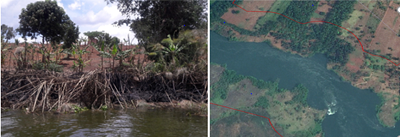Land use change
Land use change has mainly involved conversion of land to agriculture, deforestation and wetland degradation. These changes expose the soil resulting in release of sediments, organic matter, agrochemicals, and drug residues into water bodies.
Fertilizers used on farms release nitrates and phosphates into water bodies leading to eutrophication. The impacts of land use change have been gradual, cumulative, and took time to manifest on most African lakes based on the intensity of human activities in the catchment area and the morphometry of the aquatic systems. From 1970 onwards, eutrophication and pollution started to manifest on some African lakes especially those with high population densities and economic activities in the lake basins such as Lake Victoria. Climate warming altered wind regimes, mixing dynamics and water column stability which mobilized nutrients especially phosphorus, nitrogen, and silicon into the water column. This changed algal and invertebrate productivity, water transparency, stratification, oxygen levels, and fish communities. The effects of climate warming on lake productivity processes has been reported in many African lakes including Victoria, Kivu, Tanganyika, and Malawi. Many of these changes will intensify with increasing human population and climate variability and change. They should, therefore be monitored to guide adaptation and mitigation measures. Specific efforts should be made to promote sustainable land management practices.

Cultivation up to the edge of lakes and rivers exposes them to land based contaminants and should be avoided
Damming
Dams have been, and continue to be constructed along rivers flowing in and out of African lakes to provide the hydropower needed for development and to create water reservoirs for irrigation and other uses. There are five hydropower dams along the Nile between Lake Victoria and
Albert in Uganda and one dam on Sondu Miriu river in Kenya. Regulation of water flow during dam operation affect Lake Albert most of whose water balance depend on Nile inflow. There are three hydropower dams along the Omo river and irrigation schemes in the Omo valley. Given that Lake Turkana gets 90% of its water from the Omo river, it has been estimated that its level could drop by as much as 20 meters due to dam operations. Lake Kivu contributed most (~55%) to the inflow into Lake Tanganyika. There are four dams along River Ruzizi between Kivu and Tanganyika and the way they are regulated will affect the water balance of Lake Tanganyika. There are also two hydroelectric dams along the Shire river that flows from Lake Malawi. Dams alter the ecological flow of the rivers and affect ecosystem services both upstream and downstream. This affects the environment and biodiversity of rivers and associated lakes and the way the dams are managed will affect especially downstream ecosystems.

Operating of dam can affect the river downstream as illustrated by this photograph showing a situation downstream during closure (left) and release of water (right).
Urbanization
There is rapid urbanisation along the shores and within the basins of some of the African lakes. Some of the basins, like that of the Lake Victoria is expected to become completely urbanized by 2030. The Lake Victoria basin has the largest number of urban centers among all
African lakes. There are at least seven large towns/cities (Entebbe, Kampala, Jinja, Kisumu, Homa bay, Musoma, Mwanza, Bukoba) along the shores of the lake and at least nine (Masaka, Mbarara, Busia, Kitale, Eldoret, Kakamega, Kisii, Migori, Geita, Biharamuro) in the Lake Victoria basin. There are at least four towns Bujumbura, Kigoma, Mpulungu, Uvira and Kalemie along the shores of Lake Tanganyika. The shores and basin of Lake Kivu is densely populated with urban areas including Kabare, Goma, Bukavu, Gisenyi, Kibuye, and Cyanguru. There are no major urban centers along the shore and basin of Lake Albert but this is expected to change with developments associated with oil exploitation. Urbanisation attracts high human population densities which put much stress on the resources and health of the lakes. Many of the urban areas release untreated sewerage, chemical and pollutants which accumulate which cause nutrient enrichment and pollution of water bodies. This has increased input of nutrients and pollutants into the lakes especially in urban areas which has altered their health and productivity and is increasingly making the water unsuitable for human consumption and the fish could reach a level where they become unsuitable for human consumption. There is therefore need to plan urban areas properly, manage wastes, identify, monitor and plan pollution sources.

Urban waste is sometimes released into lake without treatment. This should be avoided to maintain the health and productivity of the lakes.